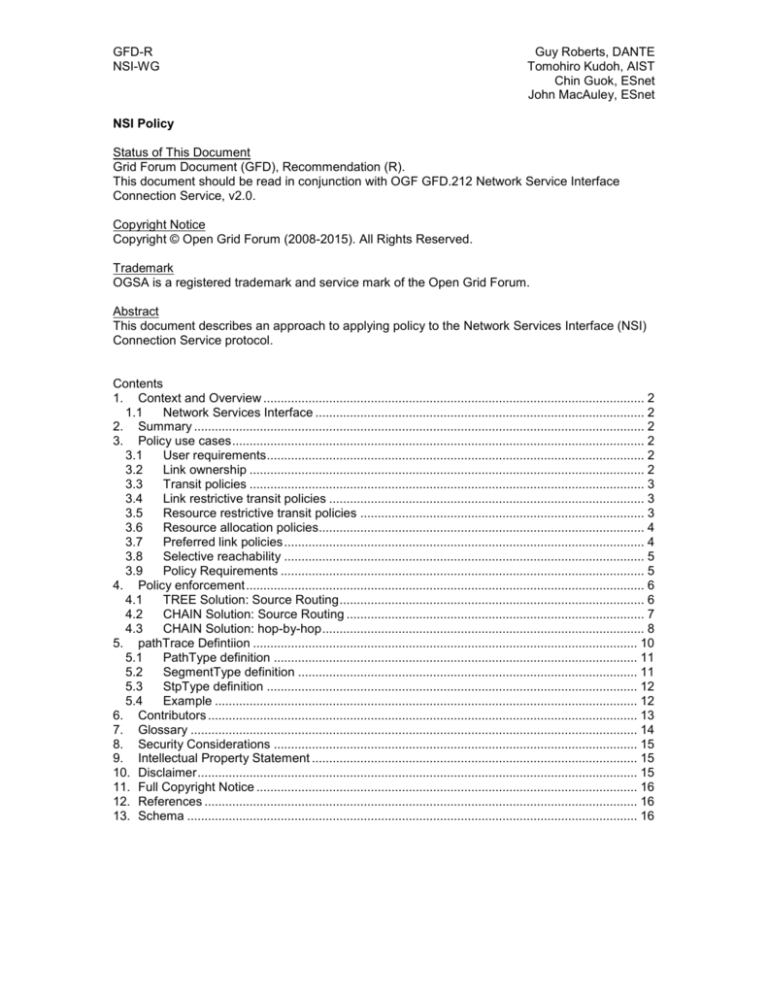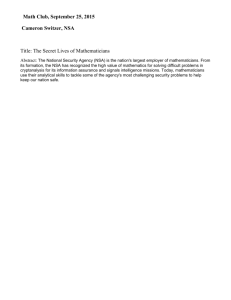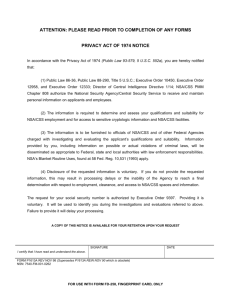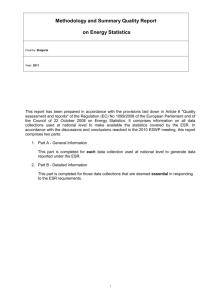
GFD-R
NSI-WG
Guy Roberts, DANTE
Tomohiro Kudoh, AIST
Chin Guok, ESnet
John MacAuley, ESnet
NSI Policy
Status of This Document
Grid Forum Document (GFD), Recommendation (R).
This document should be read in conjunction with OGF GFD.212 Network Service Interface
Connection Service, v2.0.
Copyright Notice
Copyright © Open Grid Forum (2008-2015). All Rights Reserved.
Trademark
OGSA is a registered trademark and service mark of the Open Grid Forum.
Abstract
This document describes an approach to applying policy to the Network Services Interface (NSI)
Connection Service protocol.
Contents
1. Context and Overview .............................................................................................................. 2
1.1
Network Services Interface ............................................................................................... 2
2. Summary .................................................................................................................................. 2
3. Policy use cases ....................................................................................................................... 2
3.1
User requirements ............................................................................................................. 2
3.2
Link ownership .................................................................................................................. 2
3.3
Transit policies .................................................................................................................. 3
3.4
Link restrictive transit policies ........................................................................................... 3
3.5
Resource restrictive transit policies .................................................................................. 3
3.6
Resource allocation policies.............................................................................................. 4
3.7
Preferred link policies ........................................................................................................ 4
3.8
Selective reachability ........................................................................................................ 5
3.9
Policy Requirements ......................................................................................................... 5
4. Policy enforcement ................................................................................................................... 6
4.1
TREE Solution: Source Routing ........................................................................................ 6
4.2
CHAIN Solution: Source Routing ...................................................................................... 7
4.3
CHAIN Solution: hop-by-hop ............................................................................................. 8
5. pathTrace Defintiion ............................................................................................................... 10
5.1
PathType definition ......................................................................................................... 11
5.2
SegmentType definition .................................................................................................. 11
5.3
StpType definition ........................................................................................................... 12
5.4
Example .......................................................................................................................... 12
6. Contributors ............................................................................................................................ 13
7. Glossary ................................................................................................................................. 14
8. Security Considerations ......................................................................................................... 15
9. Intellectual Property Statement .............................................................................................. 15
10. Disclaimer ............................................................................................................................... 15
11. Full Copyright Notice .............................................................................................................. 16
12. References ............................................................................................................................. 16
13. Schema .................................................................................................................................. 16
GFD-R
NSI-WG
30 April 2015
1. Context and Overview
1.1 Network Services Interface
The Network Services Interface provides an API that allows applications to monitor, control,
interrogate, and support network resources that are made available by the provider of the
network. The NSI Connection Service deals specifically with the request and management of
network Connections on transport networks. NSI is inherently agnostic to the technology used in
the transport plane. This technology agnostic approach is built into the NSI topology
representation and is supported through the use of Service Definitions.
A Connection Service can be requested by any application that has implemented an NSI CS
requester agent. Similarly, any network provider who has implemented an NSI provider agent can
service the request.
Each service is managed by an exchange of NSI messages between agents. These messages
operate using a set of service primitives. Service primitives are the set of instructions that allow
the requester to set up and manage a service. Each service request will result in the allocation of
a service id for the new service instance.
This document describes how policy is applied to the NSI Connection Service and should be read
in conjunction with GFD-R-212 Network Service Interface Connection Service version 2.0 [2],
Open Grid forum GFD-I-213, Network Services Framework v2.0 [4] and NSI Authentication and
Authorization [5].
2. Summary
Network providers all implement some level of authorization policy in their networks. This policy
will determine how each Connection request should be handled. Providers will always reserve
the right to reject connection requests that fail to meet their local policies. This document
describes how the NSI CS protocol is used to provide sufficient information to the provider to
allow them to understand the originator of the request and the routing details. The provider is
then able to apply local policy in their network based on this information.
3. Policy use cases
3.1 User requirements
This section lists policy requirements that have been identified by network providers that wish to
implement the NSI CS protocol in their network
3.2 Link ownership
In some situations a network’s demarcation point extends beyond the edge of their network to
include the link that connects to the far end network. In Figure 1 below we see Link A is owned
by Network A and Link B is owned by Network B.
Figure 1. Link ownership
In this case, the Exchange X should not be able to make a connection on port X.A without the
approval of Network A, and similarly, it cannot make a connection on port X.B without the
approval of Network B. Without a policy framework Exchange X could make a connection
between port X.A to X.B without the explicit consent from either Networks A and B, potentially
blocking bandwidth in Networks A and B, constituting a denial of service attack.
2
GFD-R
NSI-WG
30 April 2015
3.3 Transit policies
NSI CS transit policies may be applied by the uRA to determine what traffic may transit a network
based on source and/or destination network. For example in Figure 2, Network A may apply a
policy to allow Network networks A1-A3 to connect to each other without restriction while
preventing transit connections between Network B and C.
Figure 2. Transit policies
3.4 Link restrictive transit policies
NSI CS policy may be applied on a link restriction basis. In the figure below, Exchange X has a
policy that allows traffic between Network A and Network C via Links A and C1, but not using
Links A, B, and C2.
Figure 3. Link restrictive transit policies
3.5 Resource restrictive transit policies
An example of a resource based transit policy is shown in Figure 4 below. In this case Exchange
X allows a maximum bandwidth between Network A and Network C independent of the path.
3
GFD-R
NSI-WG
30 April 2015
Figure 4. Resource restrictive transit policies
3.6 Resource allocation policies
NSI CS policy can be used to restrict the path a Connection may take through the network based
on the segmentation of allocated resources within the network to specific groups of users. In the
example Figure 5 below, Link C1 is tagged for use by user group 1 only, while all other links are
tagged for cooperative sharing. Only users that are members of group 1 may use link C1 in
reservation requests.
Figure 5. Resource allocation policies
3.7 Preferred link policies
NSI CS policy can be used to prefer one link to another. In the figure below, due to transit
policies within Network C, transit traffic from Network A to Network D should use preferred Link
D1 until capacity is consumed, while transit traffic between Network B and Network D should use
preferred Link D2.
4
GFD-R
NSI-WG
30 April 2015
Figure 6. Preferred link policies
In the situation depicted below in Figure 7, there are two equal distant paths between Network A
and Network D; however, Network A has a preferred link policy such that any traffic between
Network A and D must transit Network C via Link AC, the preferred route.
Figure 7. Preferred path policies
3.8 Selective reachability
This type of policy restricts the traffic that can terminate in a network, along with transit rules for
associated traffic
A should be able to reach B+D
B should be able reach all.
C should be able to reach B+D
D should be able to reach A+B+C.
That is, A and C are not exchanging traffic, but C provides transit to D, and D has transit to A
through B and C
Figure 8. Selective reachability
3.9 Policy Requirements
The examples of policy-based routing decisions described introduce three new requirements for
path finding and for the uPA process of reservation approval:
A mechanism MUST be supported in the NSI CS protocol so that a uPA understands the
proposed end-to-end path so that it can make a decision on whether to approve the local
reservation segment.
Where a reservation is rejected for policy reasons, there MUST be a mechanism to report
this back to the uRA so that it can terminate the full end-to end reservation.
The NSI CS policy MUST assume that the responsibility for terminating Connections is
held with the uRA, this allows the uRA to make decisions on what to do under the failure
scenario.
Where a reservation is rejected for policy reasons, there MUST be a mechanism to
provide information back to the uRA about the reason for the rejection so that the uRA
can try alternative Connection requests.
5
GFD-R
NSI-WG
30 April 2015
The NSI CS policy solution MUST use the existing NSI protocol and behaviors where
possible to reduce protocol churn and allow for solution inclusion in the existing protocol
framework.
The NSI CS policy solution MUST assume that in TREE mode, full inter-network path
resolution can be performed at the root aggregator, and that in CHAIN mode; either
source or hop-by-hop routing can be performed.
Network routing policy information MUST be made available to pathfinders for more
effective route resolution.
The NSI CS policy solution MUST assume that the act of holding resources associated
with a reservation can be done without approval, but the committing of a reservation will
not occur without all uPA path segments confirmed.
The NSI CS policy solution MUST assume that the service plane is trusted and that the
NSA will behave correctly in the context of the NSI protocol.
4. Policy enforcement
This section describes how policy is enforced in the NSI Connection Service. This mechanism
makes use of the inherent Service Plane trust between NSA along with proper operation of the
NSI protocol to allow for uPA enforcement of connection path related policies. At the base of
mechanism is the definition of a new NSI message header element containing the detailed
connection path proposed for the reservation. This new path trace information is propagated to
each uPA involved in the connection as part of the NSI reserve message flow, allowing the uPA
to evaluate the full reservation path against local routing policy as part of the resource reserving
phase. A policy failure at the uPA is communicated using the standard reserveFailed message,
resulting in no changes to the core NSI CS protocol.
4.1
TREE Solution: Source Routing
This section describes how policy is implemented in the case of “source routing” for a TREE
signaled Connection reservation. The NSI models for signaling and pathfinding are documented
in detail in the NSI informational document draft-gwdi-nsi-signaling-and-path-finding [6].
A uRA creates the initial reserve message and sends it to an AG NSA that will act as the top-level
root for this reservation. The root AG NSA will resolve the full path for the reservation using any
policy information that it has access to.
Reserve messages are created for individual path segments with the fully resolved path stored in
the NSI message header along with the root AG’s NSA identifier. The root AG then routes these
individual reservation messages to the target NSA for each segment using the Service Plane.
Any AG NSA receiving a Connection reservation segment can see the full end-to-end path in the
header, and does not need to perform any further path finding (unless it is a special NSA hiding
networks behind it), and will pass equivalent reserve messages to the next hop NSAs down the
TREE until the leaf uPA involved in the connection are reached.
A uPA receives the reserve request and uses the full path information in the NSI message header
to determine if the request meets local policy requirements.
6
GFD-R
NSI-WG
30 April 2015
If the proposed path violates any local policy, a reserveFailed message is retuned with
the appropriate serviceException information. The reserveFailed message is sent up the
tree to the root AG.
If the proposed path passes all policies, and the reservation criteria can be met,
resources are held and a reserveConfirmed message is returned as per existing protocol
definition. The reserveConfirmed message is sent up the TREE to the root AG.
If a policy was violated, the root AG will inform the uRA of the reservation failure due to policy
error, and the uRA can abort the reservation as per the standard, OR the root AG can take
corrective action itself, aborting the existing path segments, and using the learned policy
information to compute an alternative path.
Figure 1 - TREE source routing reserve message flow.
4.2
CHAIN Solution: Source Routing
This section describes how policy is implemented in the case of “source routing” for a CHAIN
signaled Connection reservation. The NSI models for signaling and path finding are documented
in detail in the NSI informational document draft-gwdi-nsi-signaling-and-path-finding [6]. In the
CHAIN solution each NSA associated with network resources is both an AG and uPA, with the
AG capable of performing path finding and message forwarding, and the uPA managing
associated network resources. For the purpose of this description we use the term NSA as the
combined AG/uPA capabilities, and uRA for the standard initiator of the reservation request.
A uRA creates the initial reserve message and sends it to the head end NSA for the CHAIN that
will act as the root for this reservation (this is the NSA associated with the network of the source
7
GFD-R
NSI-WG
30 April 2015
STP). The head-end NSA then resolves the full path for the reservation using any policy
information that it has access to.
A Reserve message is created by the head-end NSA, adding the ERO for the fully resolved path
through the transport plane. In addition, the detailed path is also stored in the NSI header
(tagged as type source routing) along with the head-end NSA identifier for use by policy
enforcement. The head-end NSA, after validating any local polices and securing associated
resources, routes this reserve message to the adjacent NSA along the Transport Plane of this
connection path.
The next hop NSA receives the reserve request and uses the full path information in the header
to determine if the request meets local policy requirements.
If the proposed path violates any local policy, a reserveFailed message is retuned with
the appropriate serviceException information. The reserveFailed message is sent back
down the CHAIN to the head-end NSA.
If the proposed path passes all policies, and the reservation criteria can be met,
resources are held and a reserve message is send to the next NSA along the CHAIN.
If this was the tail end NSA then a reserveConfirmed message is returned. The
reserveConfirmed message is sent back down the CHAIN to the head-end NSA.
If a policy was violated, the head-end NSA will inform the uRA of the reservation failure due to
policy error, and the uRA can abort the reservation as per the standard. OR the head-end NSA
can take corrective action itself, aborting the existing path segments, and using the learned policy
information to compute an alternative path.
Figure 2 - CHAIN source-routing reserve message flow.
4.3
CHAIN Solution: hop-by-hop
This section describes how policy is implemented for the case of “hop-by-hop” routing for a
CHAIN signaled Connection reservation. The NSI models for signaling and pathfinding are
documented in detail in the NSI informational document draft-gwdi-nsi-signaling-and-path-finding
8
GFD-R
NSI-WG
30 April 2015
[6]. Similar to the previous CHAIN section, we use the term NSA as the combined AG/uPA
capabilities, and uRA for the standard initiator of the reservation request.
A uRA creates the initial reserve message and sends it to the head end NSA for the CHAIN that
will act as the root for this reservation (this is the NSA associated with the network of the source
STP). The hop-by-hop routing solution functions similar to the CHAIN-based source routing
solution except the complete path a reservation takes is not known until the tail end NSA is
reached. As the reserve request propagates from source network to destination network:
Hop-by-hop routing (distance vectors, etc.) are used to determine the outgoing SDP in
each Network.
The NSA holds local network resources associated with the reservation.
The proposed local path segment is added to the NSI header and the reserve is
propagated to the next peer NSA in the CHAIN.
An early fail can occur if the computed path up to this point violates any policies within
the NSA, and a reserveFailed message is returned to the adjacent upstream peer.
When the tail end NSA in the destination network is reached:
The NSA resolves the local path segment and holds associated resources (if available).
The NSA adds the local path segment to the existing path taken from the header to
complete the full path.
The NSA evaluates local policies against the full computed path, and if valid from its
perspective, returns the full path in the NSI header of the reserverConfirmed to the
adjacent upstream peer.
If the proposed path violates any policy, a reserveFailed message is retuned with
appropriate serviceException information.
As the reserveConfirmed messages propagate back from destination to source, each NSA
performs policy evaluation against the full path within the NSI header before issuing a
reserveConfirmed to the next adjacent peer.
At any point if an NSA fails policy evaluation, a reserveFailed is generated thereby failing the
reservation as per standard protocol behaviors.
Once the head-end NSA has approved the final path, a reserveConfirmed can be returned to the
originating uRA.
9
GFD-R
NSI-WG
30 April 2015
Figure 3 – CHAIN hop-by-hop routing reserve message flow.
5. pathTrace Defintiion
To help facilitate the communication of path trace information within the NSI reserve message
exchange we introduce a new schema element called “pathTrace” into the NSI Header element.
Figure 4 – The pathTrace element.
The pathTrace element contains the following parameters:
Parameter
Type
id
Attr
M/O
M
Description
In the case of TREE, this attribute contains the NSA identifier of the
aggregator that performed path resolution, while for CHAIN, it is the
identifier of the first (head-end) NSA allocating transport plane
resources. This identifier is added for traceability back to the NSA
performing initial path resolution.
10
GFD-R
NSI-WG
type
30 April 2015
Attr
M
connectionId
Elem
M
path
Elem
M
5.1
Identifies the type of routing performed for this path allocation. If
type is set to "source" then the full end-to-end path was computed at
the root NSA of the reservation and included in the reserve request.
If type is set to “hop-by-hop” then the full path will be built as the
reserve request propagates through the network.
The connection identifier for the reservation in the context of the NSA
identified by the id attribute. This identifier is added for traceability to
the originating reservation associated with this path.
In the case of a "source" routing the NSA doing path resolution
includes the complete path, while for “hop-by-hop” each NSA
allocating data plane resources adds its path segment on the
outbound reserve request until the full path is completed by the tail
end NSA. This path element is used by uPA to perform routing
policy enforcement.
PathType definition
PathType is a type definition for path information within the path trace element. A path consists
of a sequence of individual path segments.
Figure 5 – The PathType definition.
The PathType structure contains the following parameters:
Parameter
Type
segment
Elem
5.2
M/O
M
Description
One of more segment elements in the overall connection path.
SegmentType definition
SegmentType is a type definition for an individual path segment within the overall connection
path. This represents the connection segment for a single domain.
11
GFD-R
NSI-WG
30 April 2015
Figure 6 – The SegmentType definition.
The SegmentType structure contains the following parameters:
Parameter
Type
id
order
Attr
Attr
M
M
Elem
M
stp
5.3
M/O
Description
The NSA identifier associated with this path segment.
The sequence order of the connection in the overall path. As new
segments are added to the path trace this value is increased by one
over the last added segment.
A list of STP identifier within this domain that are part of the overall
path ordered by their sequence within the connection. This list will
usually only contain ingress and egress STP, however, more
flexibility is provided to model internal STP as well.
StpType definition
An extended type definition for an STP identifier that includes ordering capabilities. This type
extends from the based point-to-point service type’s StpIdType definition (a simple string valued
type) to include an order attribute.
Figure 7 – The StpType definition.
The StpType structure contains the following parameters:
Parameter
Type
order
Attr
5.4
M/O
M
Description
The order of this STP within a sequence of STP.
Example
The following is path trace example for a connection with three segments running through
networks “Aruba”, “Curacao”, and “Bonaire”. In this example, the user requests a reservation
from “stpA” in network Aruba through to “stpZ” in network Bonaire using the Grenada uRA
“urn:ogf:network:grenada.net:2013:nsa-requester”.
The Grenada uRA NSA creates an NSI reserve message with the requested reservation criteria
and passes it on to the associated aggregator NSA “urn:ogf:network:grenada.net:2013:nsa-aggr”
12
GFD-R
NSI-WG
30 April 2015
for processing. The AG receives the NSI reserve message and performs path finding. The path
shown below in Figure 8 is computed { (stpA, toCuracao), (toAruba, toBonaire), (toCuracao, stpZ)
}.
Figure 8 – Example network for pathTrace.
The AG now creates a pathTrace element to include in the NSI message header. The AG
populates pathTrace.id attribute with its own NSA identifier as the NSA performing path finding. It
also sets the pathTrace.type attribute to “source” routing identifying that the complete path has
been supplied, and populates the local connectionId associated with the reservation in the
pathTrace.connectionId element for the purpose of traceability. Finally, the AG populates the
pathTrace.path element with the detailed path ordered from source to destination, including the
individual uPA NSA identifier in the path.id attribute for each of the segments.
For this example the AG would generate the following pathTrace element:
<tns:pathTrace id="urn:ogf:network:grenada.net:2013:nsa-aggr" type="source"
xmlns:tns="http://schemas.ogf.org/nsi/2015/04/connection/pathtrace">
<connectionId>urn:uuid:59d6c0b2-a8e0-4583-ae8a-0fc84eb89f07</connectionId>
<path>
<segment id="urn:ogf:network:aruba.net:2013:nsa" order="0">
<stp order="0">urn:ogf:network:aruba.net:2013::stpA?vlan=1790</stp>
<stp order="1">urn:ogf:network:aruba.net:2013::toCuracao?vlan=1790</stp>
</segment>
<segment id="urn:ogf:network:curacao.net:2013:nsa" order="1">
<stp order="0">urn:ogf:network:curacao.net:2013::toAruba?vlan=1790</stp>
<stp order="1">urn:ogf:network:curacao.net:2013::toBonaire?vlan=1790</stp>
</segment>
<segment id="urn:ogf:network:bonaire.net:2013:nsa" order="2">
<stp order="0">urn:ogf:network:bonaire.net:2013::toCuracao?vlan=1790</stp>
<stp order="1">urn:ogf:network:bonaire.net:2013::stpZ?vlan=1790</stp>
</segment>
</path>
</tns:pathTrace>
6. Contributors
Chin Guok, ESnet
Tomohiro Kudoh, AIST
13
GFD-R
NSI-WG
30 April 2015
John MacAuley, ESnet
Guy Roberts, GEANT
Henrik Thostrup Jensen, NORDUnet
Hans Trompert, SURFnet
7. Glossary
Aggregator (AG)
The Aggregator is an NSA that has more than one child NSA, and has the
responsibility of aggregating the responses from each child NSA.
Connection
A Connection is an NSI construct that identifies the physical instance of a circuit in the
Transport Plane. A Connection has a set of properties (for instance, Connection
identifier, ingress and egress STPs, capacity, or start time). Connections can be either
unidirectional or bidirectional.
Connection Service (CS)
The NSI Connection Service is a service that allows an RA to request and manage a
Connection from a PA.
Control and Management
Planes
The Control Plane and/or Management Plane are not defined in this document, but
follow common usage.
Discovery Service
The NSI discovery service is a web service that allows an RA to discover information
about the services available in a PA and the versions of these services.
Edge Point
A network resource that resides at the boundary of an intra-network topology, this may
include for example a connector on a distribution frame, a port on an Ethernet switch,
or a connector at the end of a fiber
ero
An Explicit Routing Object (ero) is a parameter in a Connection request. It is an
ordered list of STP constraints to be used by the inter-Network pathfinder.
Inter-Network Topology
This is a topological description of a set of Networks and their transfer functions, and
the connectivity between Networks.
Network
A Network is an Inter-Network topology object that describes a set of STPs with a
Transfer Function between STPs.
Network Markup Language
(NML)
The Network Markup Language is an XML based network resource description
language developed in the OGF.
Network Resource Manager
(NRM)
The Network Resource Manager is the entity that manages a network, typically this
will be the equipment vendor’s network management system.
Network Services
Network Services are the full set of services offered by an NSA. Each NSA will
support one or more Network Services.
Network Service Agent (NSA)
The Network Service Agent is a concrete piece of software that sends and receives
NSI Messages. The NSA includes a set of capabilities that allow Network Services to
be delivered.
Network Services Framework
(NSF)
The Network Services framework describes an NSI message-based platform capable
of supporting a suite of Network Services such as the Connection Service and the
Topology Service.
Network Service Interface
(NSI)
The NSI is the interface between RAs and PAs. The NSI defines a set of interactions
or transactions between these NSAs to realize a Network Service.
NSI Message
An NSI Message is a structured unit of data sent between an RA and a PA.
NSI Topology
The NSI Topology defines a standard ontology and a schema to describe network
resources that are managed to create the NSI service. The NSI Topology as used by
the NSI CS (and in future other NSI services) is described in: GWD-R-P: Network
Service Interface Topology Representation [3].
Open Grid Forum (OGF)
The OGF is the Standards Developing Organization (SDO) that is home to the NSI
Standards.
Provision
Provisioning is the process of requesting the creation of the physical instance of a
Connection in the data plane.
Requester/Provider Agent
(RA/PA)
An NSA acts in one of two possible roles relative to a particular instance of an NSI.
When an NSA requests a service, it is called a Requester Agent (RA). When an NSA
realizes a service, it is called a Provider Agent (PA). A particular NSA may act in
different roles at different interfaces.
14
GFD-R
NSI-WG
30 April 2015
Service Demarcation Point
(SDP)
Service Demarcation Points (SDPs) are NSI topology objects that identify a grouping
of two Edge Points at the boundary between two Networks.
Service Termination Point
(STP)
Service Termination Points (STPs) are NSI topology objects that identify the Edge
Points of a Network in the intra-network topology.
Service Plane
The Service Plane is a plane in which services are requested and managed; these
services include the Network Service. The Service Plane contains a set of Network
Service Agents communicating using Network Service Interfaces.
Reserve
When a Provider Agent receives (and then confirms) a Connection Reservation
request the Provider Agent then holds the resources needed by the Connection.
Terminate
Terminating is the process which will completely remove a Reservation and Release
any associated Connections. This term has a formal definition in the CS statemachine.
Topology Distribution Service
The NSI Topology distribution Service is a service that allows the NSI topology to be
exchanged between NSAs.
Transport Plane
The Transport Plane refers to the infrastructure that carries the physical instance of
the Connection, e.g. the Ethernet switches that deliver the circuit.
Ultimate PA (uPA)
The ultimate PA is a Provider Agent that has an associated NRM.
Ultimate RA (uRA)
The ultimate RA is a Requester Agent is the originator of a service request.
XML Schema Definition
(XSD)
XSD is a schema language for XML.
eXtensible Markup Language
(XML)
XML is a markup language that defines a set of rules for encoding documents in a
format that is both human-readable and machine-readable.
8.
Security Considerations
Security considerations are dealt with in Open Grid forum GWD-R draft-trompert-gwdi-nsi-aa-v04,
NSI Authentication and Authorization [5].
No additional security issues have been raised.
9. Intellectual Property Statement
The OGF takes no position regarding the validity or scope of any intellectual property or other
rights that might be claimed to pertain to the implementation or use of the technology described in
this document or the extent to which any license under such rights might or might not be
available; neither does it represent that it has made any effort to identify any such rights. Copies
of claims of rights made available for publication and any assurances of licenses to be made
available, or the result of an attempt made to obtain a general license or permission for the use of
such proprietary rights by implementers or users of this specification can be obtained from the
OGF Secretariat.
The OGF invites any interested party to bring to its attention any copyrights, patents or patent
applications, or other proprietary rights which may cover technology that may be required to
practice this recommendation. Please address the information to the OGF Executive Director.
10. Disclaimer
This document and the information contained herein is provided on an “As Is” basis and the OGF
disclaims all warranties, express or implied, including but not limited to any warranty that the use
of the information herein will not infringe any rights or any implied warranties of merchantability or
fitness for a particular purpose.
15
GFD-R
NSI-WG
30 April 2015
11. Full Copyright Notice
Copyright (C) Open Grid Forum (2008–2015). All Rights Reserved.
This document and translations of it may be copied and furnished to others, and derivative works
that comment on or otherwise explain it or assist in its implementation may be prepared, copied,
published and distributed, in whole or in part, without restriction of any kind, provided that the
above copyright notice and this paragraph are included on all such copies and derivative works.
However, this document itself may not be modified in any way, such as by removing the copyright
notice or references to the OGF or other organizations, except as needed for the purpose of
developing Grid Recommendations in which case the procedures for copyrights defined in the
OGF Document process must be followed, or as required to translate it into languages other than
English.
The limited permissions granted above are perpetual and will not be revoked by the OGF or its
successors or assignees.
12. References
1. ITU-T, G.805: Generic functional architecture of transport networks
2. OGF GFD.212 Network Service Interface Connection Service, v2.0
3. IETF RFC 4655, "A Path Computation Element (PCE)-Based Architecture",
http://www.rfc-editor.org/rfc/rfc4655.txt
4. Open Grid forum GFD-I-213, Network Services Framework v2.0,
http://www.ogf.org/documents/GFD.213.pdf
5. Open Grid forum GWD-R draft-trompert-gwdi-nsi-aa-v04, NSI Authentication and
Authorization, https://redmine.ogf.org/dmsf_files/13398?download=
6. draft-gwdi-nsi-signaling-and-path-finding Network Services Interface Signaling and
Pathfinding https://redmine.ogf.org/dmsf_files/13327
13. Schema
<?xml version="1.0" encoding="UTF-8"?>
<!-The OGF takes no position regarding the validity or scope of any intellectual
property or other rights that might be claimed to pertain to the implementation or use of
the technology described in this document or the extent to which any license under such
rights might or might not be available; neither does it represent that it has made any
effort to identify any such rights. Copies of claims of rights made available for
publication and any assurances of licenses to be made available, or the result of an
attempt made to obtain a general license or permission for the use of such proprietary
rights by implementers or users of this specification can be obtained from the OGF
Secretariat.
The OGF invites any interested party to bring to its attention any copyrights,
patents or patent applications, or other proprietary rights which may cover technology
that may be required to practice this recommendation. Please address the information to
the OGF Executive Director.
This document and
and the OGF disclaims
any warranty that the
implied warranties of
the information contained herein is provided on an "As Is" basis
all warranties, express or implied, including but not limited to
use of the information herein will not infringe any rights or any
merchantability or fitness for a particular purpose.
Copyright (C) Open Grid Forum (2009-2015). All Rights Reserved.
This document and translations of it may be copied and furnished to others, and
16
GFD-R
NSI-WG
30 April 2015
derivative works that comment on or otherwise explain it or assist in its implementation
may be prepared, copied, published and distributed, in whole or in part, without
restriction of any kind, provided that the above copyright notice and this paragraph are
included on all such copies and derivative works. However, this document itself may not
be modified in any way, such as by removing the copyright notice or references to the OGF
or other organizations, except as needed for the purpose of developing Grid
Recommendations in which case the procedures for copyrights defined in the OGF Document
process must be followed, or as required to translate it into languages other than
English.
The limited permissions granted above are perpetual and will not be revoked by the
OGF or its successors or assignees.
Open Grid Forum NSI Connection Services Protocol v2.0 - Path trace extensions.
-->
<xsd:schema targetNamespace="http://schemas.ogf.org/nsi/2015/04/connection/pathtrace"
xmlns:xsd="http://www.w3.org/2001/XMLSchema"
xmlns:types="http://schemas.ogf.org/nsi/2013/12/services/types"
xmlns:ftypes="http://schemas.ogf.org/nsi/2013/12/framework/types"
xmlns:tns="http://schemas.ogf.org/nsi/2015/04/connection/pathtrace">
<xsd:annotation>
<xsd:appinfo>OGF NSI CS Path Trace 2015-04-30</xsd:appinfo>
<xsd:documentation xml:lang="en">
This is an XML schema document describing the path trace extension
to the OGF NSI Connection Services protocol version 2.0. This
defines a new header element used to model the full path of a
reservation.
</xsd:documentation>
</xsd:annotation>
<!-- Import the common NSI framework types. -->
<xsd:import namespace="http://schemas.ogf.org/nsi/2013/12/framework/types"
schemaLocation="ogf_nsi_framework_types_v2_0.xsd"/>
<!-- Import the common NSI service types. -->
<xsd:import namespace="http://schemas.ogf.org/nsi/2013/12/services/types"
schemaLocation="ogf_nsi_services_types_v2_0.xsd"/>
<xsd:element name="pathTrace" type="tns:PathTraceType">
<xsd:annotation>
<xsd:documentation xml:lang="en">
The header element modeling a connection path through the network.
</xsd:documentation>
</xsd:annotation>
</xsd:element>
<xsd:complexType name="PathTraceType">
<xsd:annotation>
<xsd:documentation xml:lang="en">
Type definition for the path trace information.
Attributes:
id - In the case of TREE, this attribute contains the NSA
identifier of the aggregator that performed path resolution,
while for CHAIN, it is the identifier of the first (head-end)
NSA allocating transport plane resources. This identifier is
added for traceability back to the NSA performing initial
path resolution.
type - Identifies the type of routing performed for this path
allocation. If type is set to "source" then the full end-to-end
path was computed at the root NSA of the reservation and
included in the reserve request. If type is set to “hop-by-hop”
then the full path will be built as the reserve request
propagates through the network.
Elements:
connectionId - Connection identifier for the reservation in the
17
GFD-R
NSI-WG
30 April 2015
context of the NSA identified by the "id" attribute. This
identifier is added for traceability to the originating reservation
associated with this path.
path - In the case of a "source" routing the NSA doing path
resolution includes the complete path, while for “hop-by-hop”
each NSA allocating data plane resources adds its path
segment on the outbound reserve request until the full path is
completed by the tail end NSA. This path element is used by
uPA to perform routing policy enforcement.
</xsd:documentation>
</xsd:annotation>
<xsd:sequence>
<xsd:element name="connectionId" type="ftypes:ConnectionIdType" />
<xsd:element name="path" type="tns:PathType" maxOccurs="unbounded" />
</xsd:sequence>
<xsd:attribute
name="id" type="ftypes:NsaIdType" use="required" />
<xsd:attribute
name="type" type="tns:RoutingType" use="required" />
</xsd:complexType>
<xsd:complexType name="PathType">
<xsd:annotation>
<xsd:documentation xml:lang="en">
Type definition for path information within the trace. A path
consist of a sequence of path segments.
Elements:
segment - A single segment in the overall connection path.
</xsd:documentation>
</xsd:annotation>
<xsd:sequence>
<xsd:element name="segment"
type="tns:SegmentType" maxOccurs="unbounded" />
</xsd:sequence>
</xsd:complexType>
<xsd:complexType name="SegmentType">
<xsd:annotation>
<xsd:documentation xml:lang="en">
Type definition for a path segment within the overall
connection path. This represents the connection segment for a
single domain.
Attributes:
id - The NSA identifier associated with this path segment.
order - The sequence order of the connection in the overall
path. As new segments are added to the path trace this value
is increased by one over the last added segment.
Elements:
stp - A list of STP identifier within this domain that are part
of the overall path ordered by their sequence within the
connection. This list will usually only contain an ingress and
egress STP, however, more flexibility is provided to model
internal STP as well.
</xsd:documentation>
</xsd:annotation>
<xsd:sequence>
<xsd:element name="stp" type="tns:StpType" maxOccurs="unbounded" />
</xsd:sequence>
<xsd:attribute
name="id"
type="ftypes:NsaIdType" use="required" />
<xsd:attribute
name="order" type="xsd:int" use="required" />
</xsd:complexType>
<xsd:complexType name="StpType">
<xsd:annotation>
<xsd:documentation xml:lang="en">
An extended type definition for an STP identifier that includes
18
GFD-R
NSI-WG
30 April 2015
ordering capabilities.
Attributes:
order - The order of this STP within a sequence of STP.
</xsd:documentation>
</xsd:annotation>
<xsd:simpleContent>
<xsd:extension base="types:StpIdType">
<xsd:attribute name="order" type="xsd:int" use="required"/>
</xsd:extension>
</xsd:simpleContent>
</xsd:complexType>
<xsd:simpleType name="RoutingType">
<xsd:annotation>
<xsd:documentation xml:lang="en">
Type definition enumerating the types of routing supported by
the path trace.
</xsd:documentation>
</xsd:annotation>
<xsd:restriction base="xsd:string">
<xsd:enumeration value="source" />
<xsd:enumeration value="hop-by-hop" />
</xsd:restriction>
</xsd:simpleType>
</xsd:schema>
19










